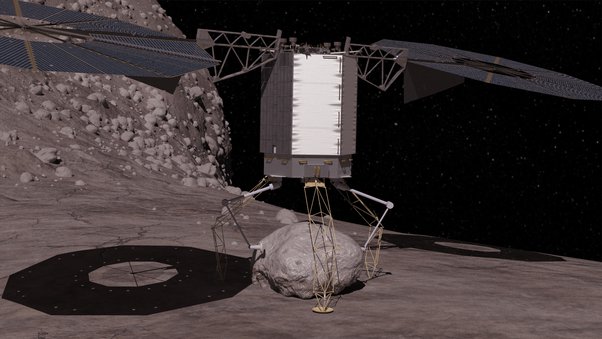Asteroid Mining is a process of drawing out minerals from the asteroids and other minor planets near Earth, with the help of asteroid mining robots. With the progress of technology, the interest in space has been brought back. In this article, we will provide you with all information about the robots in asteroid mining and the technology related to this work.

Global organizations launching their projects in Space
Hayabusa2
JAXA developed Hayabusa2, a Japanese spacecraft launched in 2014 with the goal of studying the asteroid Ryugu and returning the sample to Earth.
The spacecraft reached Ryugu in 2018 and depart after spending one year there with a sample in 2019.
One of the most important accomplishments of the Hayabusa2 mission was the development of two small rovers and landers on the surface of Ryugu.
Hayabusa2 also used a device called the Small Carry-on Impactor (SCI). The device creates an artificial crater on the surface of Ryugu.
The information collected by Hayabusa2 could be useful for the future as it provides insight into the composition and properties of asteroids.
Also, Ryugu is a C-type asteroid, which means it is rich in organic compounds and water.
Overall, the Hayabusa2 mission represents an important step toward the study of asteroids and the development of technologies for space research.
OSIRIS -REX
OSIRIS-REX, a NASA spacecraft mission launched in 2016. The goal of this mission was of studying the asteroid Bennu and returning back to Earth with a sample of its surface.
The spacecraft arrived at Bennu in December 2018. It started studying the asteroid’s surface using scientific instruments like, cameras, spectrometers, and a laser altimeter. In October 2020, the spacecraft touched down on the surface of Bennu and collected samples with a device called Touch-And-Go Acquisition Mechanism (TAGSAM). The spacecraft will return back to Earth in September 2023, where it will be analyzed by scientists in laboratories around the world.
OSIRIS-REX mission is a key part of NASA’s efforts to explore the solar system and understand its history and evaluation.
VIPER
Volatile Investigating Polar Exploration Rover is NASA’s mission which is currently under development. The goal of the mission is to search for water and other resources on the lunar surface.
NASA and other space organizations are studying the future possibility of asteroid mining. One of the concepts called the Asteroid Redirect Mission(ARM), was proposed by NASA in 2013. The main goal of ARM was to send a spacecraft to capture a small asteroid and bring it back to Earth for further analysis.
While the ARM concept has since been canceled, NASA and other space agencies are still studying the possibility of asteroid mining missions.
Origin Space
US and China both the countries are on their way to exploiting the natural resources in space by mining asteroids. Now, a space startup in China is taking its first step towards identifying and drawing out off-Earth resources.
Origin Space, a Beijing-based private space resource company, launched its first space-mining robot in November NEO-1. The robot however will not be doing actual mining, instead it will be testing technologies.
“The goal is to verify and demonstrate multiple functions such as spacecraft orbital maneuver, simulated small celestial body capture, intelligent spacecraft identification, and control,” says Yu Tianhong, the co-founder of Origin Space.
“In the future, the NEO series satellite could clear space debris by dragging it out of orbit and burning it in the atmosphere, and accurately capture space debris that may pose a threat to spacecraft and other targets to protect the safety of space facilities.” Su Meng, founder, and CEO of Origin Space, told the Global Times.
Private Companies Making Strides in Asteroid Mining
Since the foundation of the world’s first asteroid mining company, Planetary Resources, many firms have entered this sector.
Some of the companies who are involved in this process are :
• Space Fab.US: The company develops low-cost spacecraft that can be used for asteroid mining and other space missions. http://www.spacefab.us
• OffWorld: The company develops robots and other technologies for asteroid mining and other space applications. https:www.offworld.ai
• Deep Space Industries: Deep Space Industries, or DSI, is an American private company operating space technology and resource. The company was founded in 2013 and focused on developing technologies for asteroid mining. http://deepspaceindustries.com/
• Planetary Resources: The company was founded in 2009. Their goal is to extract the water from asteroids, which can be used as a propellant for spacecraft. In 2018 the company was acquired by ConsenSys. http://www.planetaryresources.com/
• Astroforge: A private company founded in 2021, situated in the USA. The company aims to become the first industry to mine the asteroid and bring back the material to Earth. It’s aiming to do as early as the end of the decade. https://www.astroforge.io
Types of Robots in Asteroid Mining
Prospecting robots: These are specially designed in a way to explore and survey the asteroids. The types of equipment used in these robots are sensors such as spectrometers, radars, and cameras. These robots can analyze the surface of the asteroid and determine the structure, composition of the asteroid. These types of robots also collect samples for further research.
Excavation robots: The basic work of these types of robots are drilling and extracting. These robots can be either surface-based or subsurface-based, depending on the nature of the asteroid. Surface-based robots use drills and scoops for extracting the mineral while Subsurface-based robots tunnel into the asteroid through drilling.
Processing robots: Once the material was collected processing robots started refining the extracted material. These robots do the work by using techniques like smelting, leaching, and chemical processing. They refine the extracted mineral
from the asteroid
Transport robots: The robots are specially designed for the transportation of extracted material, from the mining site to the transport vessel.
Maintenance robot: These robots are responsible for maintaining the mining equipment and the life support system for human crew members. These machines may use the tools such as welding torches and cutting tools to repair the damaged equipment.
Autonomous mining robots: Autonomous robots use advanced algorithms and machines to make decisions about where and how to mine. The robots are able to operate themselves without humans. They are also capable to adapt changing conditions and can optimize their operations to maximize efficiency and minimize waste.
Overall, asteroid mining robots are a key technology for space resource utilization. Providing the means to extract and process valuable resources from asteroids in a safe, efficient, and sustainable manner.
Challenges:
As much as the new technique is good, challenges also come to the fore. There are many factors that make the task difficult for the robots. Some of them are technical while others are natural.
Asteroids are located far from the earth, which can make communication difficult due to the distance and communication problem its leads to delays in robots and their operations which make the activities difficult to operate things in real-time. Due to the harsh outer space environment, the work may take time to operate or do things completely.
Asteroids have irregular shapes and surfaces, which can make it difficult for the robots to identify and navigate and move around. This can also make it challenging for robots to find and extract the resource. Extracting the resource in a harsh environment is a big challenge for both robots and the space crew.
Also the development and deployment of asteroid mining robots requires significant time and money. The return is uncertain, and it can be difficult to secure the funds for long-term projects.

Does Asteroid mining still have a future?
What happened to the space mining industry? A decade ago, the mainstream media was full of articles about how mining asteroids for minerals and off-earth metals would revolutionize the commercial space economy.
The hype of knowing space makes the mainstream media so cynical and weary of the best-laid plans. How many times we have heard the mantra ‘it’s back to the Moon and then on to Mars’, before anyone sets foot on the Red Planet? Much less thinks about mining Mars? Or drilling the asteroid?
“I think we all overestimated what could be done”, Jeff Karger, a former U.S. Geological Survey (USGS) geologist who is now a senior scientist at the Planetary Science Institute in Tucson, Arizona said.
One sure sign that asteroid mining has shifted from science fiction to serious business is when companies are being formed around the processes and governments are regulating how to authorize ownership of these interplanetary resources. U.S. government policies seem to consider asteroid resources to be fair game to whoever can exploit them, much like ocean resources that lie outside the coastal boundary of any country.
Overall there are a lot of potential benefits of asteroid mining robots and many companies and organizations actively perusing this technology. There are still many changes that have to overcome, the future seems hopeful for the development of this technique.
Asteroid mining would be incredibly expensive, but at some point, the cost of obtaining these rapidly depleting materials on Earth will be greater than the recovery costs related to space mining.
Also, learn about Boston Dynamics’ Spot, the robot dog, and Atlas, the humanoid


